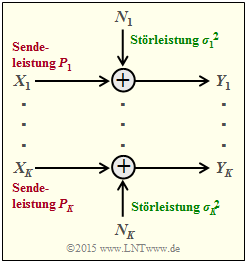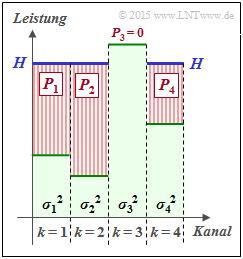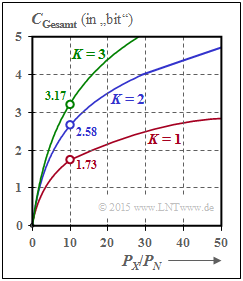Difference between revisions of "Information Theory/AWGN Channel Capacity for Continuous-Valued Input"
| Line 77: | Line 77: | ||
\hspace{0.15cm}{\rm d}x\hspace{0.15cm}{\rm d}y.$$ | \hspace{0.15cm}{\rm d}x\hspace{0.15cm}{\rm d}y.$$ | ||
| − | The significance of these two information-theoretic quantities will be discussed in more detail in [[Aufgaben: | + | The significance of these two information-theoretic quantities will be discussed in more detail in [[Aufgaben:Exercise_4.5Z:_Again_Mutual_Information|Exercise 4.5Z]] . |
If one compares the graphical representations of the mutual information for | If one compares the graphical representations of the mutual information for | ||
| − | *value-discrete random variables in the section [[Information_Theory/ | + | *value-discrete random variables in the section [[Information_Theory/Application_to_Digital_Signal_Transmission#Information-theoretical_model_of_digital_signal_transmission|Information-theoretical model of digital signal transmission]], |
*value-continuous random variables according to the above diagram, | *value-continuous random variables according to the above diagram, | ||
Revision as of 17:37, 19 August 2021
Contents
Mutual information between value-continuous random variables
In the chapter Information-theoretical model of digital signal transmission the "mutual information" between the two value-discrete random variables $X$ and $Y$ was given, among other things, in the following form:
- $$I(X;Y) = \hspace{0.5cm} \sum_{\hspace{-0.9cm}y \hspace{0.1cm}\in \hspace{0.1cm}{\rm supp}\hspace{0.05cm} (P_{Y}\hspace{-0.08cm})} \hspace{-1.1cm}\sum_{\hspace{1.3cm} x \hspace{0.1cm}\in \hspace{0.1cm}{\rm supp}\hspace{0.05cm} (P_{X}\hspace{-0.08cm})} \hspace{-0.9cm} P_{XY}(x, y) \cdot {\rm log} \hspace{0.1cm} \frac{ P_{XY}(x, y)}{P_{X}(x) \cdot P_{Y}(y)} \hspace{0.05cm}.$$
This equation simultaneously corresponds to the Kullback–Leibler distance between the joint probability function $P_{XY}$ and the product of the two individual probability functions $P_X$ and $P_Y$ :
- $$I(X;Y) = D(P_{XY} \hspace{0.05cm} || \hspace{0.05cm}P_{X} \cdot P_{Y}) \hspace{0.05cm}.$$
In order to derive the mutual information $I(X; Y)$ between two value-continuous random variables $X$ and $Y$, one proceeds as follows, whereby inverted commas indicate a quantised variable:
- One quantises the random variables $X$ and $Y$ $($with the quantisation intervals ${\it Δ}x$ and ${\it Δ}y)$ and thus obtains the probability functions $P_{X\hspace{0.01cm}′}$ and $P_{Y\hspace{0.01cm}′}$.
- The „vectors” $P_{X\hspace{0.01cm}′}$ and $P_{Y\hspace{0.01cm}′}$ become infinitely long after the boundary transitions ${\it Δ}x → 0,\hspace{0.1cm} {\it Δ}y → 0$ , and the joint PMF $P_{X\hspace{0.01cm}′\hspace{0.08cm}Y\hspace{0.01cm}′}$ is also infinitely extended in area.
- These boundary transitions give rise to the probability density functions of the continuous random variables according to the following equations:
- $$f_X(x_{\mu}) = \frac{P_{X\hspace{0.01cm}'}(x_{\mu})}{\it \Delta_x} \hspace{0.05cm}, \hspace{0.3cm}f_Y(y_{\mu}) = \frac{P_{Y\hspace{0.01cm}'}(y_{\mu})}{\it \Delta_y} \hspace{0.05cm}, \hspace{0.3cm}f_{XY}(x_{\mu}\hspace{0.05cm}, y_{\mu}) = \frac{P_{X\hspace{0.01cm}'\hspace{0.03cm}Y\hspace{0.01cm}'}(x_{\mu}\hspace{0.05cm}, y_{\mu})} {{\it \Delta_x} \cdot {\it \Delta_y}} \hspace{0.05cm}.$$
- The double sum in the above equation, after renaming $Δx → {\rm d}x$ and $Δy → {\rm d}y$ , becomes the equation valid for continuous value random variables:
- $$I(X;Y) = \hspace{0.5cm} \int\limits_{\hspace{-0.9cm}y \hspace{0.1cm}\in \hspace{0.1cm}{\rm supp}\hspace{0.05cm} (P_{Y}\hspace{-0.08cm})} \hspace{-1.1cm}\int\limits_{\hspace{1.3cm} x \hspace{0.1cm}\in \hspace{0.1cm}{\rm supp}\hspace{0.05cm} (P_{X}\hspace{-0.08cm})} \hspace{-0.9cm} f_{XY}(x, y) \cdot {\rm log} \hspace{0.1cm} \frac{ f_{XY}(x, y) } {f_{X}(x) \cdot f_{Y}(y)} \hspace{0.15cm}{\rm d}x\hspace{0.15cm}{\rm d}y \hspace{0.05cm}.$$
$\text{Conclusion:}$ By splitting this double integral, it is also possible to write for the »mutual information«:
- $$I(X;Y) = h(X) + h(Y) - h(XY)\hspace{0.05cm}.$$
The »joint differential entropy«
- $$h(XY) = - \hspace{-0.3cm}\int\limits_{\hspace{-0.9cm}y \hspace{0.1cm}\in \hspace{0.1cm}{\rm supp}\hspace{0.05cm} (P_{Y}\hspace{-0.08cm})} \hspace{-1.1cm}\int\limits_{\hspace{1.3cm} x \hspace{0.1cm}\in \hspace{0.1cm}{\rm supp}\hspace{0.05cm} (P_{X}\hspace{-0.08cm})} \hspace{-0.9cm} f_{XY}(x, y) \cdot {\rm log} \hspace{0.1cm} \hspace{0.1cm} \big[f_{XY}(x, y) \big] \hspace{0.15cm}{\rm d}x\hspace{0.15cm}{\rm d}y$$
and the two »differential single entropies«
- $$h(X) = -\hspace{-0.7cm} \int\limits_{x \hspace{0.05cm}\in \hspace{0.05cm}{\rm supp}\hspace{0.03cm} (\hspace{-0.03cm}f_X)} \hspace{-0.35cm} f_X(x) \cdot {\rm log} \hspace{0.1cm} \big[f_X(x)\big] \hspace{0.1cm}{\rm d}x \hspace{0.05cm},\hspace{0.5cm} h(Y) = -\hspace{-0.7cm} \int\limits_{y \hspace{0.05cm}\in \hspace{0.05cm}{\rm supp}\hspace{0.03cm} (\hspace{-0.03cm}f_Y)} \hspace{-0.35cm} f_Y(y) \cdot {\rm log} \hspace{0.1cm} \big[f_Y(y)\big] \hspace{0.1cm}{\rm d}y \hspace{0.05cm}.$$
On equivocation and irrelevance
We further assume the value-continuous mutual information $I(X;Y) = h(X) + h(Y) - h(XY)$ . This representation is also found in the following diagram (left graph).
From this you can see that the mutual information can also be represented as follows:
- $$I(X;Y) = h(Y) - h(Y \hspace{-0.1cm}\mid \hspace{-0.1cm} X) =h(X) - h(X \hspace{-0.1cm}\mid \hspace{-0.1cm} Y)\hspace{0.05cm}.$$
These fundamental information-theoretical relationships can also be read from the graph on the right. This directional representation is particularly suitable for communication systems.
The outflowing or inflowing differential entropy characterises
- the equivocation:
- $$h(X \hspace{-0.05cm}\mid \hspace{-0.05cm} Y) = - \hspace{-0.3cm}\int\limits_{\hspace{-0.9cm}y \hspace{0.1cm}\in \hspace{0.1cm}{\rm supp}\hspace{0.05cm} (P_{Y}\hspace{-0.08cm})} \hspace{-1.1cm}\int\limits_{\hspace{1.3cm} x \hspace{0.1cm}\in \hspace{0.1cm}{\rm supp}\hspace{0.05cm} (P_{X}\hspace{-0.08cm})} \hspace{-0.9cm} f_{XY}(x, y) \cdot {\rm log} \hspace{0.1cm} \hspace{0.1cm} \big [{f_{\hspace{0.03cm}X \mid \hspace{0.03cm} Y} (x \hspace{-0.05cm}\mid \hspace{-0.05cm} y)} \big] \hspace{0.15cm}{\rm d}x\hspace{0.15cm}{\rm d}y,$$
- the irrelevance:
- $$h(Y \hspace{-0.05cm}\mid \hspace{-0.05cm} X) = - \hspace{-0.3cm}\int\limits_{\hspace{-0.9cm}y \hspace{0.1cm}\in \hspace{0.1cm}{\rm supp}\hspace{0.05cm} (P_{Y}\hspace{-0.08cm})} \hspace{-1.1cm}\int\limits_{\hspace{1.3cm} x \hspace{0.1cm}\in \hspace{0.1cm}{\rm supp}\hspace{0.05cm} (P_{X}\hspace{-0.08cm})} \hspace{-0.9cm} f_{XY}(x, y) \cdot {\rm log} \hspace{0.1cm} \hspace{0.1cm} \big [{f_{\hspace{0.03cm}Y \mid \hspace{0.03cm} X} (y \hspace{-0.05cm}\mid \hspace{-0.05cm} x)} \big] \hspace{0.15cm}{\rm d}x\hspace{0.15cm}{\rm d}y.$$
The significance of these two information-theoretic quantities will be discussed in more detail in Exercise 4.5Z .
If one compares the graphical representations of the mutual information for
- value-discrete random variables in the section Information-theoretical model of digital signal transmission,
- value-continuous random variables according to the above diagram,
the only distinguishing feature is that each (capital) $H$ (entropy; $\ge 0$) has been replaced by a (non-capital) $h$ (differential entropy; can be positive, negative or zero).
- Otherwise, the mutual information is the same in both representations and $I(X; Y) ≥ 0$ always applies.
- In the following, we mostly use the "binary logarithm" ⇒ $\log_2$ and thus obtain the mutual information in "bit".
Calculation of mutual information with additive noise
We now consider a very simple model of message transmission:
- The random variable $X$ stands for the (zero mean) transmission signal and is characterised by the PDF $f_X(x)$ and the variance $σ_X^2$ . The transmission power is $P_X = σ_X^2$.
- The additive noise $N$ is given by the PDF $f_N(n)$ and the noise power $P_N = σ_N^2$ .
- If $X$ and $N$ are assumed to be statistically independent ⇒ signal-independent noise, then $\text{E}\big[X · N \big] = \text{E}\big[X \big] · \text{E}\big[N\big] = 0$ .
- The received signal is $Y = X + N$. The output PDF $f_Y(y)$ can be calculated with the convolution operation ⇒ $f_Y(y) = f_X(x) ∗ f_N(n)$.
- For the received power (variance) holds:
- $$P_Y = \sigma_Y^2 = {\rm E}\big[Y^2\big] = {\rm E}\big[(X+N)^2\big] = {\rm E}\big[X^2\big] + {\rm E}\big[N^2\big] = \sigma_X^2 + \sigma_N^2 $$
- $$\Rightarrow \hspace{0.3cm} P_Y = P_X + P_N \hspace{0.05cm}.$$
The sketched density functions sketched (rectangular or trapezoidal) are only intended to clarify the calculation process and have no practical relevance.
To calculate the mutual information between input $X$ and output $Y$ there are three possibilities according to the graphic on the previous subchapter drei Möglichkeiten:
- Calculation according to $I(X, Y) = h(X) + h(Y) - h(XY)$:
- The first two terms can be calculated in a simple way from $f_X(x)$ and $f_Y(y)$ respectively. The joint differentrial entropy $h(XY)$ is problematic. For this, one needs the 2D joint PDF $f_{XY}(x, y)$, which is usually not given directly.
- Calculation according to $I(X, Y) = h(Y) - h(Y|X)$:
- Here $h(Y|X)$ denotes the differential scattering entropy. It holds that $h(Y|X) = h(X + N|X) = h(N)$, so that $I(X; Y)$ is very easy to calculate via the equation $f_Y(y) = f_X(x) ∗ f_N(n)$ if $f_X(x)$ and $f_N(n)$ are known.
- Calculation according to $I(X, Y) = h(X) - h(X|Y)$:
- According to this equation, however, one needs the differential inference entropy $h(X|Y)$, which is more difficult to state than $h(Y|X)$.
$\text{Conclusion:}$ In the following we use the middle equation and write for the mutual information between the input $X$ and the output $Y$ of a message transmission system in the presence of additive and uncorrelated noise $N$:
- $$I(X;Y) \hspace{-0.05cm} = \hspace{-0.01cm} h(Y) \hspace{-0.01cm}- \hspace{-0.01cm}h(N) \hspace{-0.01cm}=\hspace{-0.05cm} -\hspace{-0.7cm} \int\limits_{y \hspace{0.05cm}\in \hspace{0.05cm}{\rm supp}(f_Y)} \hspace{-0.65cm} f_Y(y) \cdot {\rm log} \hspace{0.1cm} \big[f_Y(y)\big] \hspace{0.1cm}{\rm d}y +\hspace{-0.7cm} \int\limits_{n \hspace{0.05cm}\in \hspace{0.05cm}{\rm supp}(f_N)} \hspace{-0.65cm} f_N(n) \cdot {\rm log} \hspace{0.1cm} \big[f_N(n)\big] \hspace{0.1cm}{\rm d}n\hspace{0.05cm}.$$
Channel capacity of the AWGN channel
If one specifies the probability density function of the noise in the previous general system model as Gaussian corresponding to
- $$f_N(n) = \frac{1}{\sqrt{2\pi \sigma_N^2}} \cdot {\rm e}^{ - \hspace{0.05cm}{n^2}/(2 \sigma_N^2) } \hspace{0.05cm}, $$
we obtain the model sketched on the right for calculating the channel capacity of the so-called AWGN channel (Additive White Gaussian Noise). In the following, we usually replace $\sigma_N^2$ by $P_N$.
We know from previous sections:
- The channel capacity $C_{\rm AWGN}$ specifies the maximum mutual information $I(X; Y)$ between the input quantity $X$ and the output quantity $Y$ of the AWGN channel. The maximisation refers to the best possible input PDF. Thus, under the power constraint the following applies:
- $$C_{\rm AWGN} = \max_{f_X:\hspace{0.1cm} {\rm E}[X^2 ] \le P_X} \hspace{-0.35cm} I(X;Y) = -h(N) + \max_{f_X:\hspace{0.1cm} {\rm E}[X^2] \le P_X} \hspace{-0.35cm} h(Y) \hspace{0.05cm}.$$
- It is already taken into account that the maximisation relates solely to the differential entropy $h(Y)$ ⇒ PDF $f_Y(y)$ bezieht. Indeed, for a given noise power $P_N$ , $h(N) = 1/2 · \log_2 (2π{\rm e} · P_N)$ is a constant.
- The maximum for $h(Y)$ is obtained for a Gaussian PDF $f_Y(y)$ with $P_Y = P_X + P_N$ t, see page maximum differential entropy under power constraint:
- $${\rm max}\big[h(Y)\big] = 1/2 · \log_2 \big[2πe · (P_X + P_N)\big].$$
- However, the output PDF $f_Y(y) = f_X(x) ∗ f_N(n)$ is Gaussian only if both $f_X(x)$ and $f_N(n)$ are Gaussian functions. A striking saying about the convolution operation is: Gaussian remains Gaussian, and non-Gaussian never becomes (exactly) Gaussian.
$\text{Conclusion:}$ For the AWGN channel ⇒ Gaussian noise PDF $f_N(n)$ the channel capacity results exactly when the input PDF $f_X(x)$ is also Gaussian:
- $$C_{\rm AWGN} = h_{\rm max}(Y) - h(N) = 1/2 \cdot {\rm log}_2 \hspace{0.1cm} {P_Y}/{P_N}$$
- $$\Rightarrow \hspace{0.3cm} C_{\rm AWGN}= 1/2 \cdot {\rm log}_2 \hspace{0.1cm} ( 1 + P_X/P_N) \hspace{0.05cm}.$$
Parallel Gaussian channels
We now consider, according to the graph $K$ parallel Gaussian channels of $X_1 → Y_1$, ... , $X_k → Y_k$, ... , $X_K → Y_K$.
- We call the transmission powers in the $K$ channels
- $$P_1 = \text{E}[X_1^2], \hspace{0.15cm}\text{...}\hspace{0.15cm} ,\ P_k = \text{E}[X_k^2], \hspace{0.15cm}\text{...}\hspace{0.15cm} ,\ P_K = \text{E}[X_K^2].$$
- The $K$ noise powers can also be different:
- $$σ_1^2, \hspace{0.15cm}\text{...}\hspace{0.15cm} ,\ σ_k^2, \hspace{0.15cm}\text{...}\hspace{0.15cm} ,\ σ_K^2.$$
We are now looking for the maximum mutual information $I(X_1, \hspace{0.15cm}\text{...}\hspace{0.15cm}, X_K\hspace{0.05cm};\hspace{0.05cm}Y_1, \hspace{0.15cm}\text{...}\hspace{0.15cm}, Y_K) $ between
- the $K$ input variables $X_1$, ... , $X_K$ and
- the $K$ output variables $Y_1$ , ... , $Y_K$,
which we call the total channel capacity of this AWGN configuration.
$\text{Agreement:}$
AAssume power constraint of the total system. That is:
The sum of all powers $P_k$ in the $K$ individual channels must not exceed the specified value $P_X$ :
- $$P_1 + \hspace{0.05cm}\text{...}\hspace{0.05cm}+ P_K = \hspace{0.1cm} \sum_{k= 1}^K \hspace{0.1cm}{\rm E} \left [ X_k^2\right ] \le P_{X} \hspace{0.05cm}.$$
Under the only slightly restrictive assumption of independent noise sources $N_1$, ... , $N_K$ can be written for the mutual information after some intermediate steps:
- $$I(X_1, \hspace{0.05cm}\text{...}\hspace{0.05cm}, X_K\hspace{0.05cm};\hspace{0.05cm}Y_1,\hspace{0.05cm}\text{...}\hspace{0.05cm}, Y_K) = h(Y_1, ... \hspace{0.05cm}, Y_K ) - \hspace{0.1cm} \sum_{k= 1}^K \hspace{0.1cm} h(N_k)\hspace{0.05cm}.$$
The following upper bound can be specified for this:
- $$I(X_1,\hspace{0.05cm}\text{...}\hspace{0.05cm}, X_K\hspace{0.05cm};\hspace{0.05cm}Y_1, \hspace{0.05cm}\text{...} \hspace{0.05cm}, Y_K) \hspace{0.2cm} \le \hspace{0.1cm} \hspace{0.1cm} \sum_{k= 1}^K \hspace{0.1cm} \big[h(Y_k - h(N_k)\big] \hspace{0.2cm} \le \hspace{0.1cm} 1/2 \cdot \sum_{k= 1}^K \hspace{0.1cm} {\rm log}_2 \hspace{0.1cm} ( 1 + {P_k}/{\sigma_k^2}) \hspace{0.05cm}.$$
- The equal sign (identity) is valid for mean-free Gaussian input variables $X_k$ as well as for statistically independent disturbances $N_k$.
- One arrives from this equation at the maximum mutual information ⇒ channel capacity, if the total transmission power $P_X$ is divided as best as possible, taking into account the different interferences in the individual channels $(σ_k^2)$ .
- This optimisation problem can again be elegantly solved with the method of Lagrange multipliers elegant lösen. The following example only explains the result.
$\text{Beispiel 1:}$ We consider $K = 4$ parallel Gaussian channels with four different noise powers $σ_1^2$, ... , $σ_4^2$ according to the adjacent figure (faint green background).
- The best possible distribution of the transmitting power among the four channels is sought.
- If one were to slowly fill this profile with water, the water would initially flow only into $\text{channel 2}$ .
- If you continue to pour, some water will also accumulate in $\text{channel 1}$ and later also in $\text{channel 4}$.
The drawn „water level” $H$ describes exactly the point in time when the sum $P_1 + P_2 + P_4$ corresponds to the total available transmitting power $P_X$ :
- The optimal power distribution for this example results in $P_2 > P_1 > P_4$ as well as $P_3 = 0$.
- Only with a larger transmitting power $P_X$ would a small power $P_3$ also be allocated to the third channel.
This allocation procedure is called a Water–Filling algorithm.
$\text{Example 2:}$ If all $K$ Gaussian channels are equally disturbed ⇒ $σ_1^2 = \hspace{0.15cm}\text{...}\hspace{0.15cm} = σ_K^2 = P_N$,one should naturally distribute the total available transmit power $P_X$ equally to all channels:: $P_k = P_X/K$. For the total capacity one then obtains:
- $$C_{\rm Gesamt} = \frac{ K}{2} \cdot {\rm log}_2 \hspace{0.1cm} ( 1 + \frac{P_X}{K \cdot P_N}) \hspace{0.05cm}.$$
The graph shows the total capacity as a function of $P_X/P_N$ for $K = 1$, $K = 2$ and $K = 3$:
- For $P_X/P_N = 10 \ ⇒ \ 10 · \text{lg} (P_X/P_N) = 10 \ \text{dB}$ , the total capacitance becomes approximately $50\%$ larger if the total power $P_X$ is divided equally between two channels: $P_1 = P_2 = P_X/2$.
- In the borderline case $P_X/P_N → ∞$ , the total capacity increases by a factor $K$ ⇒ doubling at $K = 2$.
The two identical and independent channels can be realised in different ways, for example by multiplexing in time, frequency or space.
However, the case $K = 2$ can also be realised by using orthogonal basis functions such as „cosine” und „sine” as for example with
- quadrature amplitude modulation (QAM) oder
- einer multi-level phase modulation such as QPSK or 8–PSK.
Relevant tasks
Aufgabe 4.5: Transinformation aus 2D-WDF
Aufgabe 4.5Z: Nochmals Transinformation
Aufgabe 4.6: AWGN–Kanalkapazität
Aufgabe 4.7: Mehrere parallele Gaußkanäle
Aufgabe 4.7Z: Zum Water–Filling–Algorithmus






